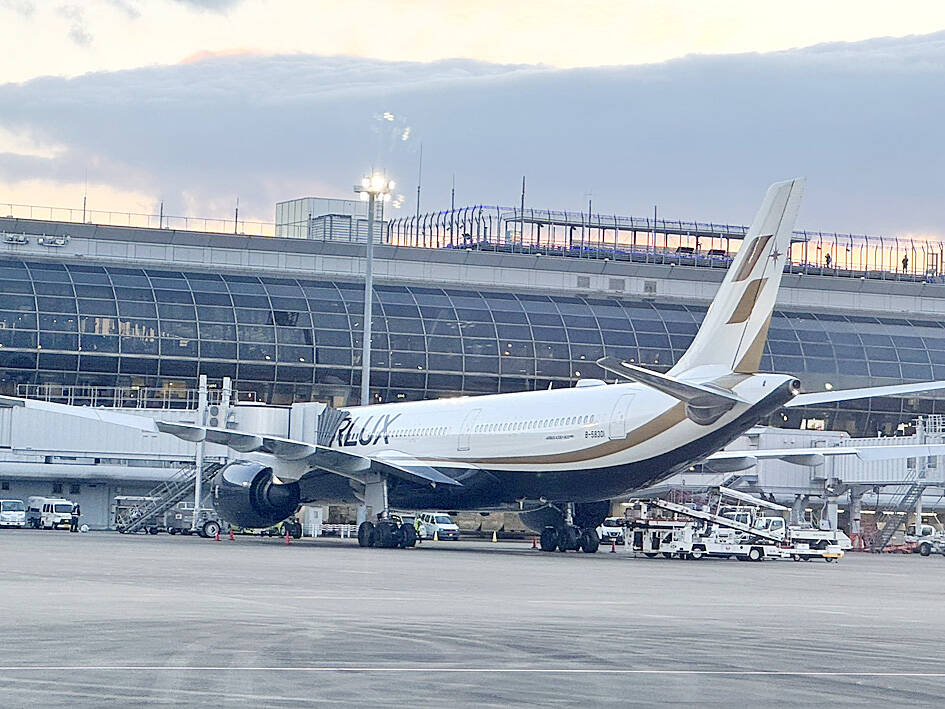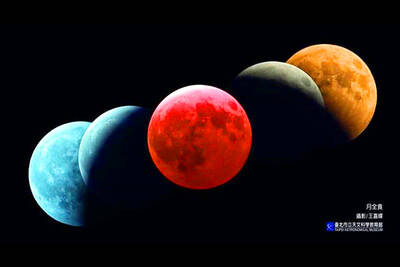Starlux Airlines yesterday announced that it would in April launch direct flights to Kobe, Japan, from Taiwan Taoyuan International Airport and Taichung International Airport, making it the first Taiwanese airline to offer services to the popular travel destination.
The flights would use Airbus A321neo aircraft, it said.
Starting on April 18, three round-trip flights would be launched between Taipei and Kobe per week in the initial phase, while seven round-trip flights would be launched from Taichung per week, it said.

Photo: CNA
Tickets went on sale yesterday.
To celebrate the launch of the routes, Starlux said it would dispatch additional flights on April 18 between Taoyuan and Kobe.
The new routes were created as travelers around the world are expected to flock to Japan’s Kansai area when the World Expo opens in Osaka City in April, it said.
The expo is scheduled to run from April 13 to Oct. 13.
Kobe Airport’s international terminal is also scheduled to begin operations on April 18, it added.
As an important port in Japan, Kobe is widely known as a “dessert city” in Japan. It also has a variety of tourist destinations in the region, such as the Arima Onsen hot springs, a town famous for its gold and silver springs, and Awaji Island, which attracts countless tourists with its magnificent natural landscape and unique cuisine, it said.
Kobe is also close to the Keihan area, and is an important hub connecting Kansai and the world, Starlux said.
It offers quick access to the World Expo venue and allows visitors to avoid the crowds, Starlux said.

Three batches of banana sauce imported from the Philippines were intercepted at the border after they were found to contain the banned industrial dye Orange G, the Food and Drug Administration (FDA) said yesterday. From today through Sept. 2 next year, all seasoning sauces from the Philippines are to be subject to the FDA’s strictest border inspection, meaning 100 percent testing for illegal dyes before entry is allowed, it said in a statement. Orange G is an industrial coloring agent that is not permitted for food use in Taiwan or internationally, said Cheng Wei-chih (鄭維智), head of the FDA’s Northern Center for

LOOKING NORTH: The base would enhance the military’s awareness of activities in the Bashi Channel, which China Coast Guard ships have been frequenting, an expert said The Philippine Navy on Thursday last week inaugurated a forward operating base in the country’s northern most province of Batanes, which at 185km from Taiwan would be strategically important in a military conflict in the Taiwan Strait. The Philippine Daily Inquirer quoted Northern Luzon Command Commander Lieutenant General Fernyl Buca as saying that the base in Mahatao would bolster the country’s northern defenses and response capabilities. The base is also a response to the “irregular presence this month of armed” of China Coast Guard vessels frequenting the Bashi Channel in the Luzon Strait just south of Taiwan, the paper reported, citing a

UNDER PRESSURE: The report cited numerous events that have happened this year to show increased coercion from China, such as military drills and legal threats The Chinese Communist Party (CCP) aims to reinforce its “one China” principle and the idea that Taiwan belongs to the People’s Republic of China by hosting celebratory events this year for the 80th anniversary of the end of World War II, the “retrocession” of Taiwan and the establishment of the UN, the Mainland Affairs Council (MAC) said in its latest report to the Legislative Yuan. Taking advantage of the significant anniversaries, Chinese officials are attempting to assert China’s sovereignty over Taiwan through interviews with international news media and cross-strait exchange events, the report said. Beijing intends to reinforce its “one China” principle

A total lunar eclipse, an astronomical event often referred to as a “blood moon,” would be visible to sky watchers in Taiwan starting just before midnight on Sunday night, the Taipei Astronomical Museum said. The phenomenon is also called “blood moon” due to the reddish-orange hue it takes on as the Earth passes directly between the sun and the moon, completely blocking direct sunlight from reaching the lunar surface. The only light is refracted by the Earth’s atmosphere, and its red wavelengths are bent toward the moon, illuminating it in a dramatic crimson light. Describing the event as the most important astronomical phenomenon